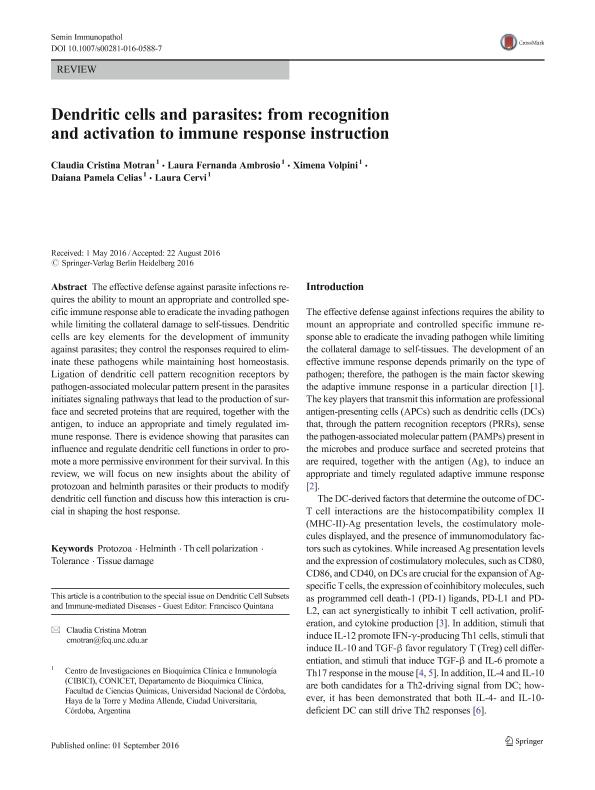Artículo
Dendritic cells and parasites: from recognition and activation to immune response instruction
Motran, Claudia Cristina ; Ambrosio, Laura Fernanda
; Ambrosio, Laura Fernanda ; Volpini, Ximena
; Volpini, Ximena ; Celias, Daiana Pamela
; Celias, Daiana Pamela ; Cervi, Laura Alejandra
; Cervi, Laura Alejandra
 ; Ambrosio, Laura Fernanda
; Ambrosio, Laura Fernanda ; Volpini, Ximena
; Volpini, Ximena ; Celias, Daiana Pamela
; Celias, Daiana Pamela ; Cervi, Laura Alejandra
; Cervi, Laura Alejandra
Fecha de publicación:
02/2017
Editorial:
Springer
Revista:
Seminars in Immunopathology
ISSN:
1863-2297
Idioma:
Inglés
Tipo de recurso:
Artículo publicado
Clasificación temática:
Resumen
The effective defense against parasite infections requires the ability to mount an appropriate and controlled specific immune response able to eradicate the invading pathogen while limiting the collateral damage to self-tissues. Dendritic cells are key elements for the development of immunity against parasites; they control the responses required to eliminate these pathogens while maintaining host homeostasis. Ligation of dendritic cell pattern recognition receptors by pathogen-associated molecular pattern present in the parasites initiates signaling pathways that lead to the production of surface and secreted proteins that are required, together with the antigen, to induce an appropriate and timely regulated immune response. There is evidence showing that parasites can influence and regulate dendritic cell functions in order to promote a more permissive environment for their survival. In this review, we will focus on new insights about the ability of protozoan and helminth parasites or their products to modify dendritic cell function and discuss how this interaction is crucial in shaping the host response.
Palabras clave:
Helminth
,
Protozoa
,
Th Cell Polarization
,
Tissue Damage
,
Tolerance
Archivos asociados
Licencia
Identificadores
Colecciones
Articulos(CIBICI)
Articulos de CENTRO DE INV.EN BIOQUI.CLINICA E INMUNOLOGIA
Articulos de CENTRO DE INV.EN BIOQUI.CLINICA E INMUNOLOGIA
Citación
Motran, Claudia Cristina; Ambrosio, Laura Fernanda; Volpini, Ximena; Celias, Daiana Pamela; Cervi, Laura Alejandra; Dendritic cells and parasites: from recognition and activation to immune response instruction; Springer; Seminars in Immunopathology; 39; 2; 2-2017; 199-213
Compartir
Altmétricas



